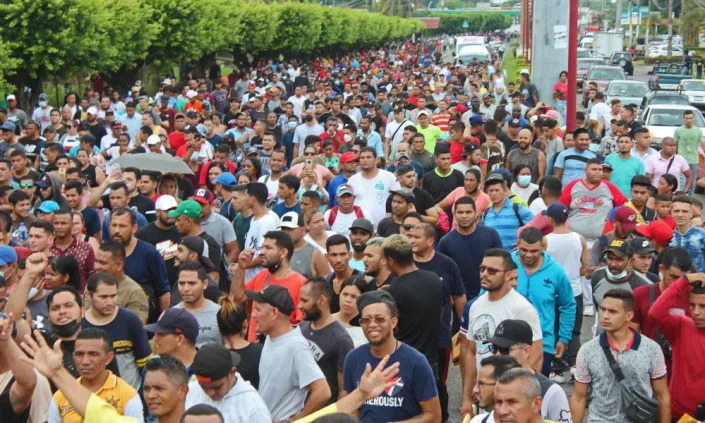Up to 15,000 may join largest ever migrant caravan to walk through Mexico to US
Lillian Perlmutter in Tapachula Fri, June 3, 2022,

Liozanys Comeja credits her survival to her teacup chihuahua, Mia. Originally from Venezuela, Comeja moved to Colombia five years ago, but decided to leave her new life behind this month due to the rising cost of living. She crossed the Darien Gap, a notorious stretch of jungle between Colombia and Panama, with Mia tucked in her backpack, eventually making her way across eight countries. Now, Comeja is hoping the dog will help her make it through the grueling final leg of their journey.
Comeja has joined about 11,000 others who on Monday will leave Tapachula, a sweltering city on the Mexico-Guatemala border, and head north for the United States. It will depart as leaders from across the hemisphere gather in Los Angeles for the Summit of the Americas.
“Whenever I get discouraged, Mia calms me down,” Comeja said. When they arrive at the US border, Comeja plans to cross the Rio Grande on foot.
This is not the first migrant caravan to leave Tapachula, but it may be the largest ever recorded in Mexico: its numbers are expected to swell in the coming days, and may reach 15,000 people – plus Mia the chihuahua.
“This is the largest mass human migration I have seen in at least the past 10 years,” said Luís Villagrán, an organizer of the caravan and director of the non-profit Center for Human Dignification.
Nearly 70% of its members are women and children, aged between infants to people in their 70s, said Villagrán. Huddled together for protection, they aim to walk the entire length of Mexico. Most have only one pair of shoes; some, just plastic flip-flops. The road they will travel, known as the coastal route, may be difficult to traverse due to mudslides left behind by Hurricane Agatha, as well as the overbearing presence of the sun.
The largest number of migrants in the caravan come from Venezuela, Cuba and Nicaragua – three countries whose authoritarian rulers Joe Biden has conspicuously refused to invite to the summit. But there are also Haitians, Salvadorans, Hondurans, Guatemalans and even citizens of India, Bangladesh, and several African countries.
Related: Cubans choose exile to escape post-protest political crackdown
Earlier this month, the Mexican National Migration Institute (INM), wrote to Villagrán, expressing sympathy for the caravan’s members and pledging to help the most vulnerable among them. The letter also acknowledges that the caravan is a result of the stunning tsunami of migration from nearly every country in the Americas to the United States in the past few years, attributing this migration to elevated rates of violence and economic instability in the continent.
It is a striking response from the leaders of a bureaucracy that migrants often describe as routinely unhelpful and even deliberately dysfunctional.
But the letter also marks the first time the Mexican government has responded to a caravan before its departure, and may signal a shift in how the authorities respond to large groups of migrants.
“Immigration is used as a political tool. These women and children are like coins to be exchanged. It’s very possible [Mexican President Andrés Manuel López] Obrador wants to use this caravan to look like a humanitarian before the Summit of the Americas,” Villagrán said.
But caravan members are well aware of the potential dangers they face. In recent months, Mexico’s National Guard has become increasingly violent in its response to migrants. When Villagrán led a smaller caravan in April, he was beaten and several of his teeth were cracked by National Guard troops.
In Tapachula, the National Guard is routinely used to corral, detain, and teargas unruly groups of migrants in front of the city’s INM office, where people often wait for weeks or months for the humanitarian visa needed to leave the city.
On Tuesday, thousands gathered at Tapachula’s city center to write their names on a list that Villagrán would submit to INM to secure visas for the group. At one point, an altercation broke out as migrants worried others would get to the list before them, and they would be left behind.
Before they depart, Villagrán and the migrants are demanding humanitarian visas be given immediately, so the group can pass through migration checkpoints without being arrested or attacked by Mexican National Guard, as happened in April. Anyone attempting to cross through one of the checkpoints without a visa is sent back to Tapachula and forced to wait months for papers that may never come.
Over the past three months, migrants have poured into Tapachula’s parks and shelters at twice or three times the previous rate. Migrant shelters that once housed no more than 400 people are now accommodating nearly 2,000. Bathrooms overflow, food dwindles until it is just one scoop of beans, and migrants sleep in the hallways, or on spread out sweatshirts in the jungle.
Grace, another traveller from Venezuela, said she only hoped that her five-year-old daughter, Bláiche, would not remember the scenes they had lived through in the crowded shelter.
“Of course I’m joining the caravan! I’m leaving as quickly as I can,” she said. “This place is a trap.”
No comments:
Post a Comment